Belkin F5D8235-4B N+ Wireless Router User Manual Manual Part 3
Belkin International, Inc. N+ Wireless Router Manual Part 3
Belkin >
Contents
- 1. Manual Part 1
- 2. Manual Part 2
- 3. Manual Part 3
Manual Part 3
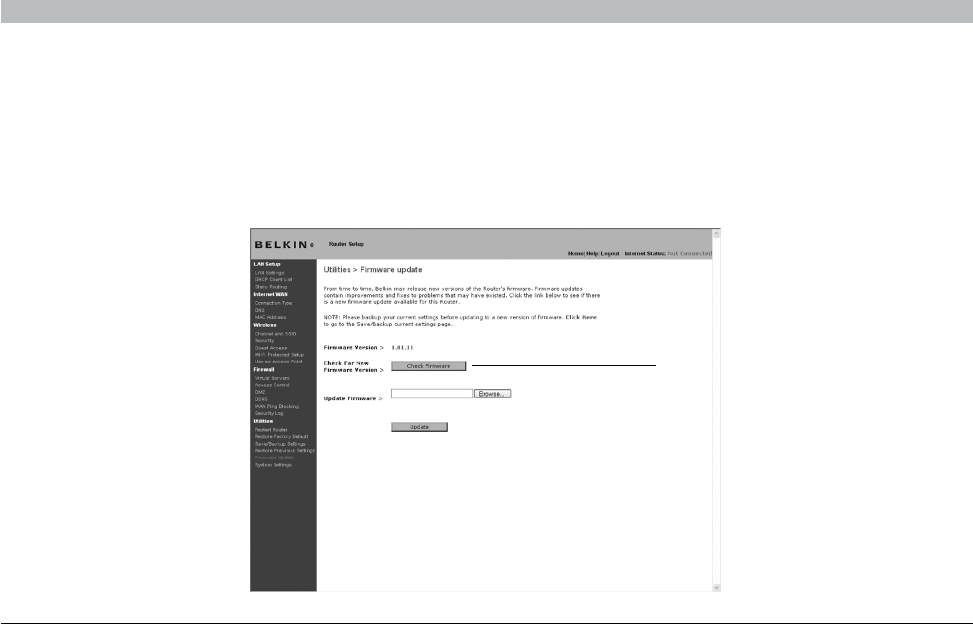
59
N+ Wireless Router
SECTIONSTable of Contents 12345 789106
USING THE WEB-BASED ADVANCED USER INTERFACE
Updating the Firmware
From time to time, Belkin may release new versions of the Router’s
firmware. Firmware updates contain feature improvements and fixes to
problems that may have existed. When Belkin releases new firmware,
you can download the firmware from the Belkin update website and
update your Router’s firmware to the latest version.
Checking for a New Version of Firmware
The “Check Firmware” (1) button allows you to instantly check for a new
version of firmware. When you click the button, a new browser window
will appear informing you that either no new firmware is available or that
there is a new version available. If a new version is available, you will
have the option to download it.
(1)
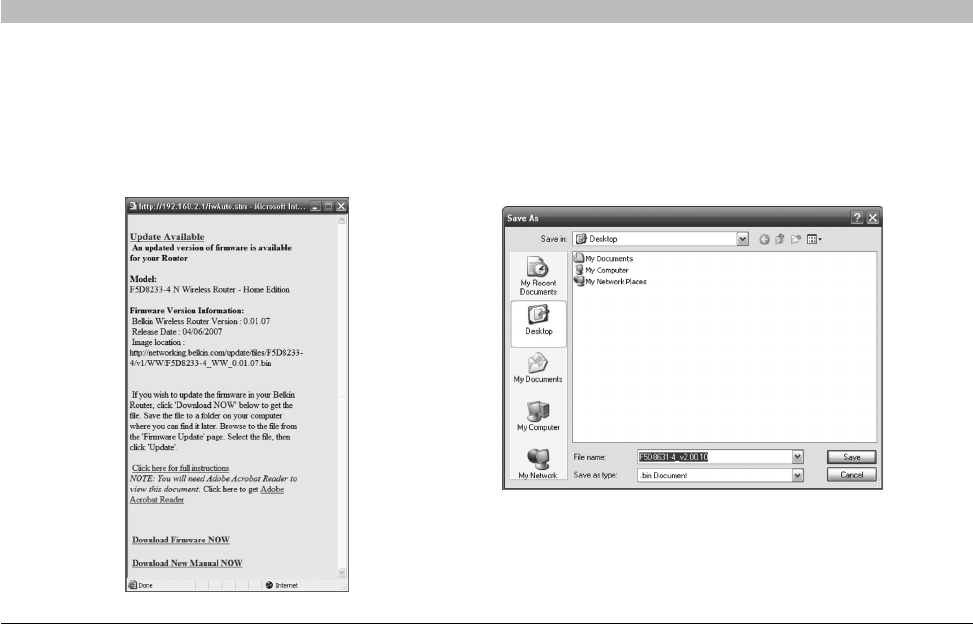
60
N+ Wireless Router
SECTIONSTable of Contents 12345 789106
USING THE WEB-BASED ADVANCED USER INTERFACE
1. To download the new version of firmware, click “Download”.
2. A window will open that allows you to select the location where you
want to save the firmware file. Select a location. You can name the
file anything you want, or use the default name. Be sure to locate
the file in a place where you can locate it yourself later. When you
have selected the location, click “Save”.
3. When the save is complete, you will see the following window. Click
“Close”.
The download of the firmware is complete. To update the firmware,
follow the next steps in “Updating the Router’s Firmware”.
Downloading a New Version of Firmware
If you click the “Check Firmware” button and a new version of firmware
is available, you will see a screen similar to the one on the right:
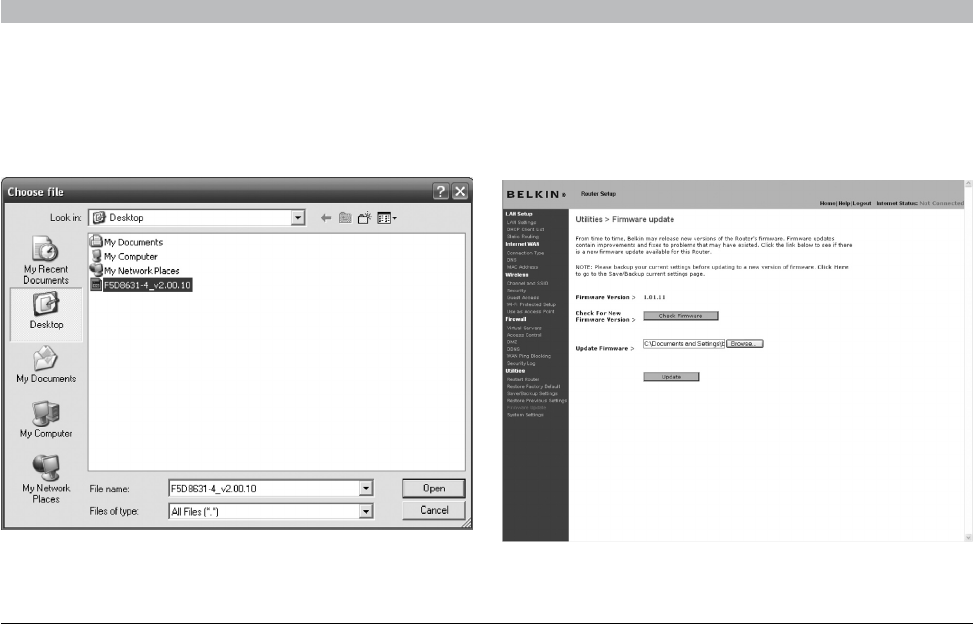
61
N+ Wireless Router
SECTIONSTable of Contents 12345 789106
USING THE WEB-BASED ADVANCED USER INTERFACE
2. Browse to the firmware file you downloaded. Select the file by
double-clicking on the file name.
3. The “Update Firmware” box will now display the location and name
of the firmware file you just selected. Click “Update”.
Updating the Router’s Firmware
1. In the “Firmware Update” page, click “Browse”. A window will open
that allows you to select the location of the firmware update file.
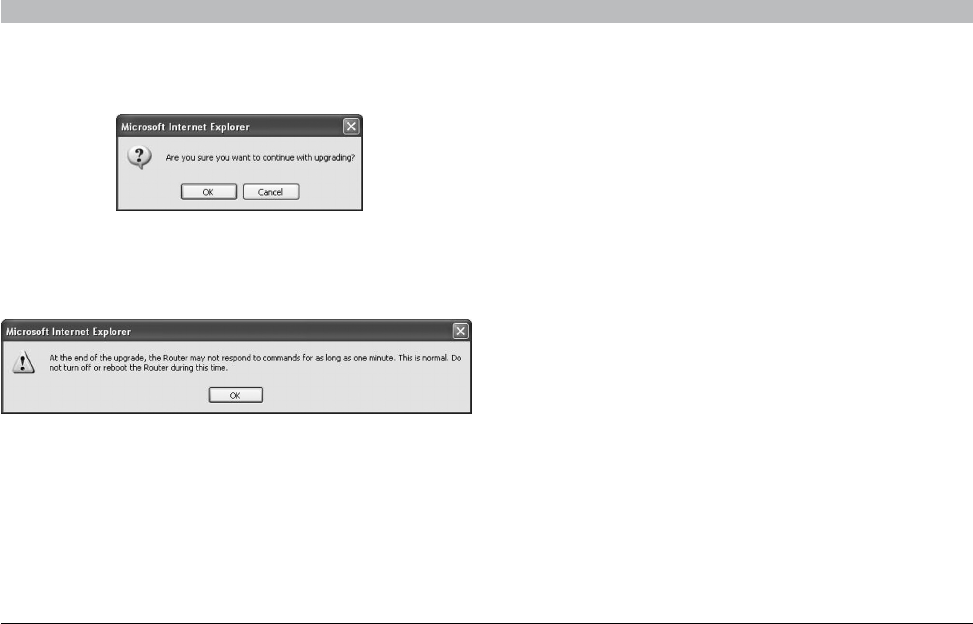
62
N+ Wireless Router
SECTIONSTable of Contents 12345 789106
USING THE WEB-BASED ADVANCED USER INTERFACE
4. You will be asked if you are sure you want to continue. Click “OK”.
5. You will see one more message. This message tells you that the
Router may not respond for as long as one minute as the firmware
is loaded into the Router and the Router is rebooted. Click “OK”.
6. A 60-second countdown will appear on the screen. When the
countdown reaches zero, the Router firmware update will be
complete. The Router home page should appear automatically. If
not, type in the Router’s address (default = 192.168.2.1) into the
navigation bar of your browser.
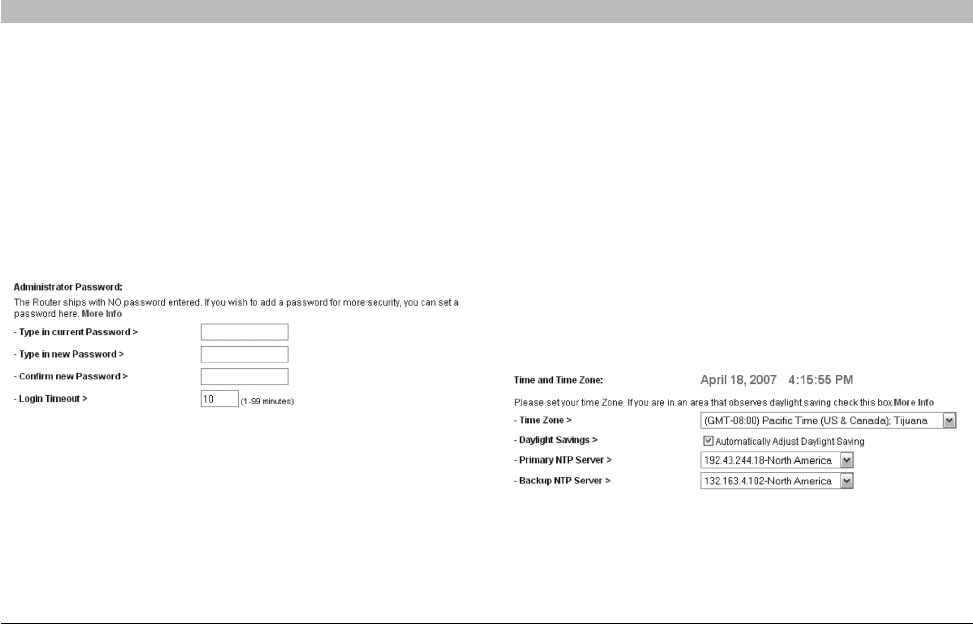
63
N+ Wireless Router
SECTIONSTable of Contents 12345 789106
USING THE WEB-BASED ADVANCED USER INTERFACE
Changing System Settings
The “System Settings” page is where you can enter a new administrator
password, set the time zone, or enable remote management.
Setting or Changing the Administrator Password
The Router ships with NO password entered. If you wish to add a
password for greater security, you can set a password here. Write down
your password and keep it in a safe place, as you will need it if you need
to log into the Router in the future. It is also recommended that you set a
password if you plan to use the remote management feature of your Router.
Setting the Time and Time Zone
The Router keeps time by connecting to a Simple Network Time
Protocol (SNTP) server. This allows the Router to synchronize the system
clock to the global Internet. The synchronized clock in the Router is
used to record the security log and control client filtering. Select the
time zone that you reside in. You have the option to select a primary and
a backup NTP server to keep your Router’s clock synchronized. Select
your desired NPT server from the drop-down box, or simply keep it as is.
If you reside in an area that observes daylight saving, then place a check
mark in the box next to “Enable Daylight Saving”. The system clock
may not update immediately. Allow at least 15 minutes for the Router to
contact the time servers on the Internet and get a response. You cannot
set the clock yourself.
Changing the Login Time-Out Setting
The login time-out option allows you to set the period of time that you can be
logged into the Router’s advanced setup interface. The timer starts when there
has been no activity. For example, imagine you have made some changes in
the advanced setup interface, then left your computer alone without clicking
“Logout”. Assuming the time-out is set to 10 minutes, 10 minutes after you
leave, the login session will expire. You will have to log into the Router again
to make any more changes. The login time-out option is for security purposes
and the default is set to 10 minutes. Note: Only one computer can be logged
into the Router’s advanced setup interface at one time.
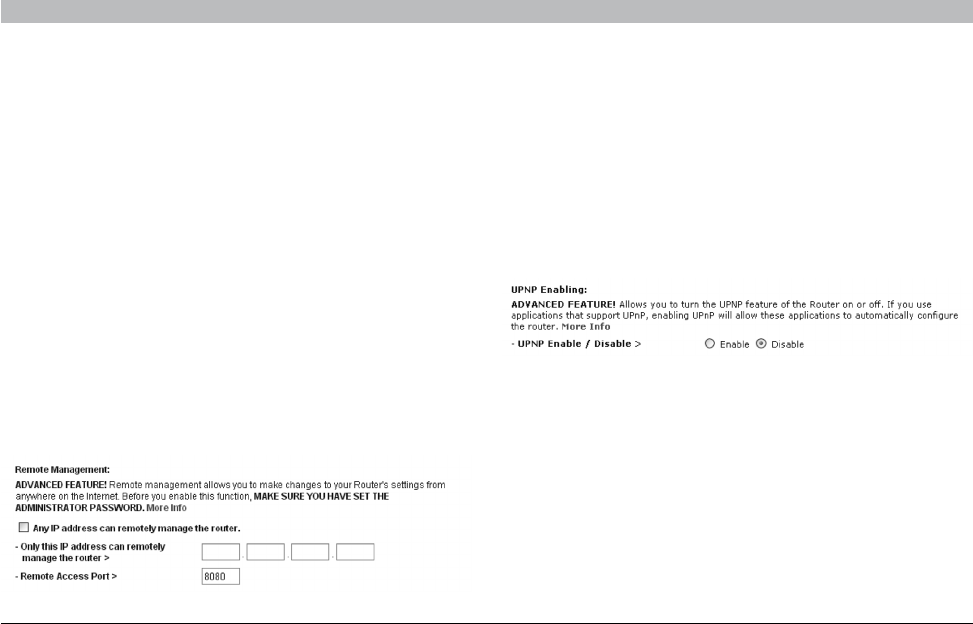
64
N+ Wireless Router
SECTIONSTable of Contents 12345 789106
USING THE WEB-BASED ADVANCED USER INTERFACE
Enabling Remote Management
Before you enable this advanced feature of your Belkin Router, MAKE
SURE YOU HAVE SET THE ADMINISTRATOR PASSWORD. Remote
management allows you to make changes to your Router’s settings from
anywhere on the Internet. There are two methods of remotely managing
the Router. The first is to allow access to the Router from anywhere
on the Internet by selecting “Any IP address can remotely manage the
Router”. By typing in your WAN IP address from any computer on the
Internet, you will be presented with a login screen where you need to
type in the password of your Router.
The second method is to allow a specific IP address only to remotely
manage the Router. This is more secure, but less convenient. To use
this method, enter the IP address you know you will be accessing the
Router from in the space provided and select “Only this IP address
can remotely manage the Router”. Before you enable this function, it is
STRONGLY RECOMMENDED that you set your administrator password.
Leaving the password empty will potentially open your Router to
intrusion.
Advanced Feature: The “Remote Access Port” option allows you to
configure the desired “Remote Access Port for Remote Management”
feature. The default access port is set to port 80.
Enabling/Disabling UPnP
UPnP (Universal Plug-and-Play) is yet another advanced feature offered
by your Belkin Router. It is a technology that offers seamless operation
of voice messaging, video messaging, games, and other applications
that are UPnP-compliant. Some applications require the Router’s firewall
to be configured in a specific way to operate properly. This usually
requires opening TCP and UDP ports, and in some instances, setting
trigger ports. An application that is UPnP-compliant has the ability to
communicate with the Router, basically “telling” the Router which way
it needs the firewall configured. The Router ships with the UPnP feature
enabled.
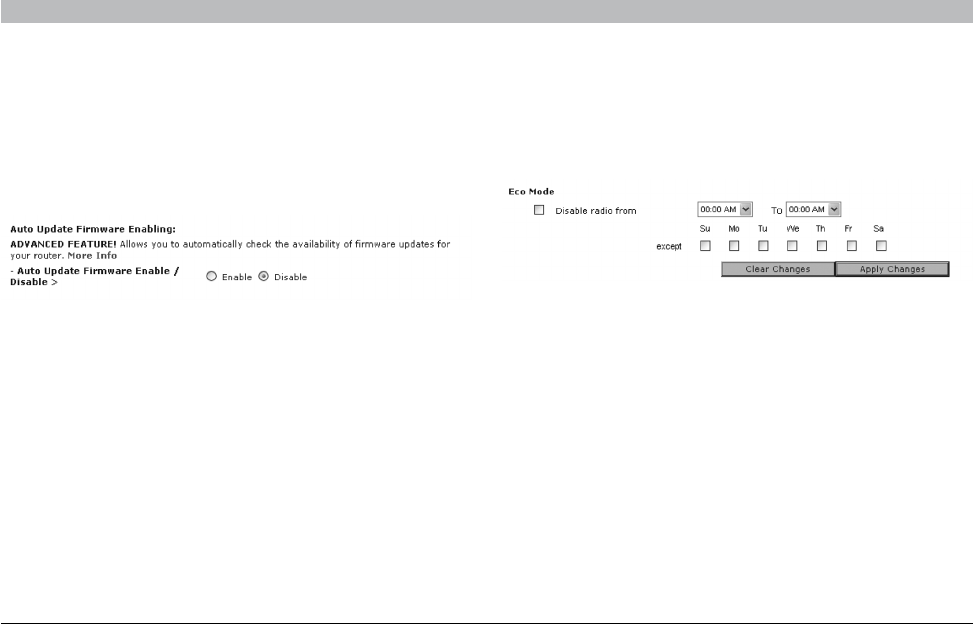
65
N+ Wireless Router
SECTIONSTable of Contents 12345 789106
USING THE WEB-BASED ADVANCED USER INTERFACE
Enabling/Disabling Auto Firmware Update
This innovation provides the Router with the built-in capability to
automatically check for a new version of firmware and alert you that
the new firmware is available. When you log into the Router’s advanced
interface, the Router will perform a check to see if new firmware is
available. If so, you will be notified. You can choose to download the
new version or ignore it.
ECO Mode: This option allows you to turn off the wireless radio
automatically at set periods of time in order to save power. Click the
check box to turn off the radio at the times shown in the drop-down
boxes.
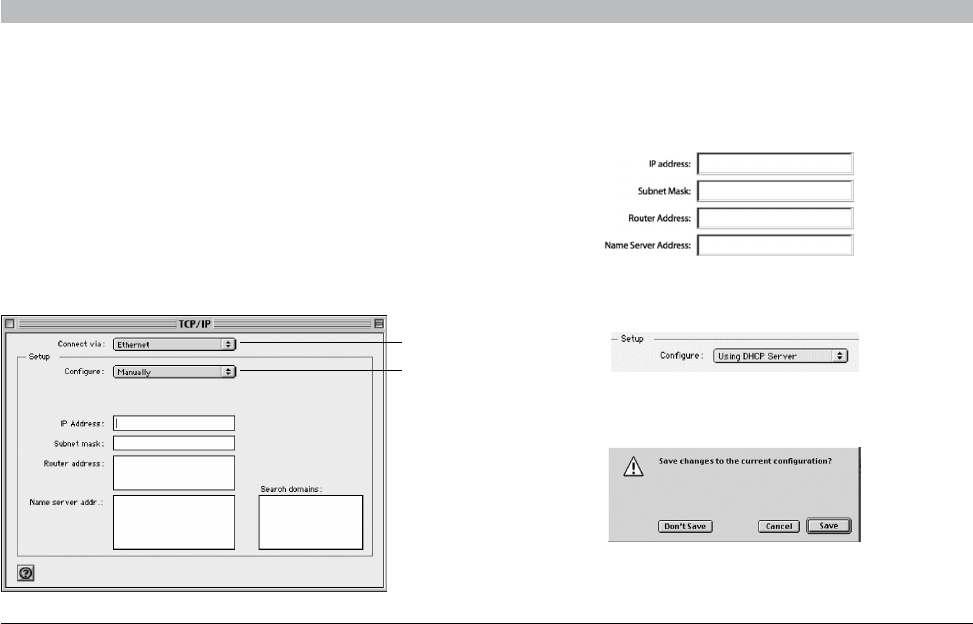
66
N+ Wireless Router
SECTIONSTable of Contents 12345 789106
USING THE WEB-BASED ADVANCED USER INTERFACE
Manually Configuring Network Settings
Set up the computer that is connected to the cable or DSL modem FIRST
using these steps. You can also use these steps to add computers to
your Router after the Router has been set up to connect to the Internet.
Manually Configuring Network Settings in Mac OS up to 9.x
1. Pull down the Apple menu. Select “Control Panels” and select
“TCP/IP”.
2. You will see the TCP/IP control panel. Select “Ethernet Built-In” or
“Ethernet” in the “Connect via:” drop-down menu (1).
3. Next to “Configure” (2), if “Manually” is selected, your Router
will need to be set up for a static IP connection type. Write the
address information in the table below. You will need to enter this
information into the Router).
4. If not already set, at “Configure:”, choose “Using DHCP Server”.
This will tell the computer to obtain an IP address from the Router.
5. Close the window. If you made any changes, the following window
will appear. Click “Save”.
Restart the computer. When the computer restarts, your network
settings are now configured for use with the Router.
(1)
(2)
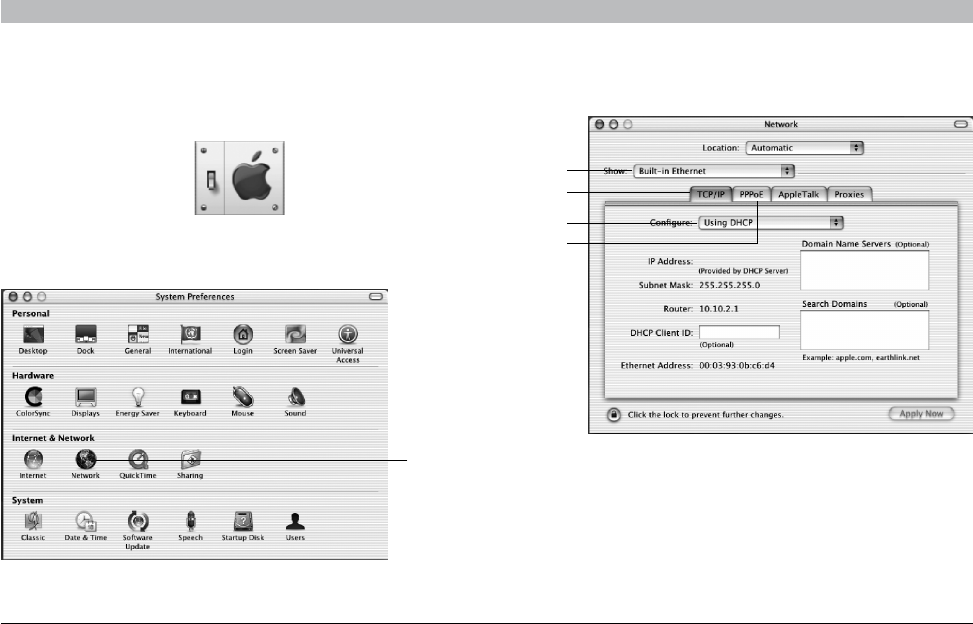
67
N+ Wireless Router
SECTIONSTable of Contents 123456 8910
MANUALLY CONFIGURING NETWORK SETTINGS
7
Manually Configuring Network Settings in Mac OS X
1. Click on the “System Preferences” icon.
2. Select “Network” (1) from the “System Preferences” menu.
3. Select “Built-in Ethernet” (2) next to “Show” in the Network menu.
4. Select the “TCP/IP” tab (3). Next to “Configure” (4), you should see
“Manually” or “Using DHCP”. If you do not, check the PPPoE tab (5)
to make sure that “Connect using PPPoE” is NOT selected. If it is,
you will need to configure your Router for a PPPoE connection type
using your user name and password.
(1)
(2)
(3)
(4)
(5)
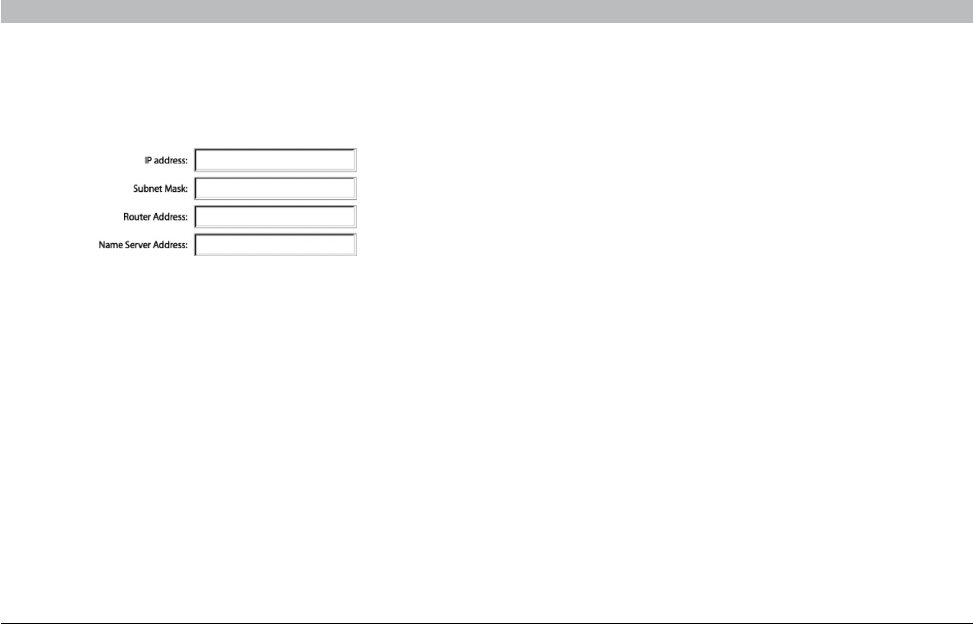
68
N+ Wireless Router
SECTIONSTable of Contents 123456 89107
MANUALLY CONFIGURING NETWORK SETTINGS
5. If “Manually” is selected, your Router will need to be set up for a
static IP connection type. Write the address information in the table
below. You will need to enter this information into the Router.
6. If not already selected, select “Using DHCP” next to “Configure” (4),
then click “Apply Now”.
Your network settings are now configured for use with the Router.
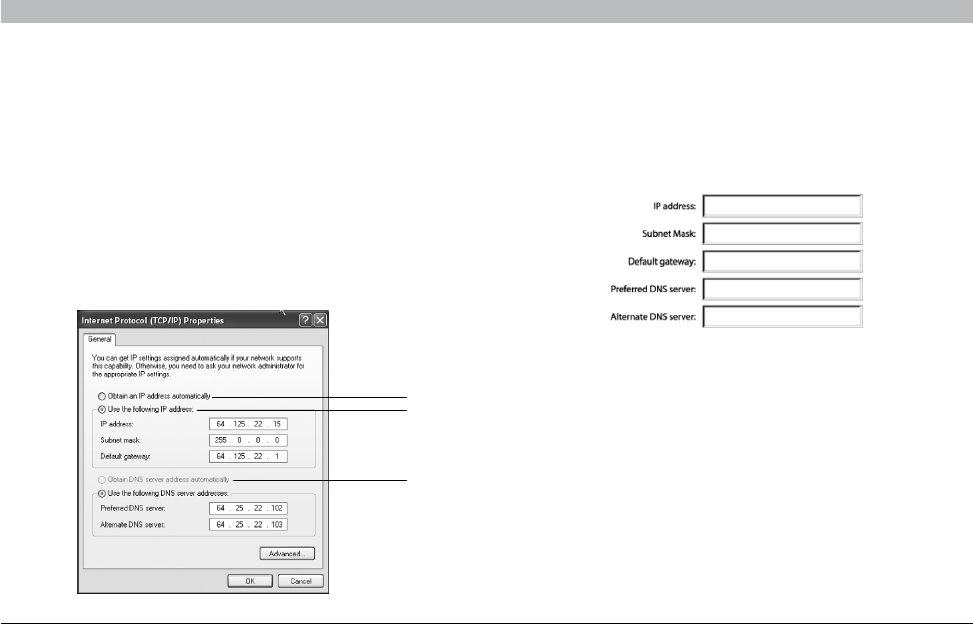
69
N+ Wireless Router
SECTIONSTable of Contents 123456 89107
MANUALLY CONFIGURING NETWORK SETTINGS
Manually Configuring Network Settings in Windows 2000, NT, or XP
1. Click “Start”, “Settings”, then “Control Panel”.
2. Double-click on the “Network and dial-up connections” icon
(Windows 2000) or the “Network” icon (Windows XP).
3. Right-click on the “Local Area Connection” associated with your
network adapter and select “Properties” from the drop-down
menu.
4. In the “Local Area Connection Properties” window, click “Internet
Protocol (TCP/IP)” and click the “Properties” button. The following
screen will appear:
(1)
(2)
(3)
5. If “Use the following IP address” (2) is selected, your Router will
need to be set up for a static IP connection type. Write the address
information the table below. You will need to enter this information
into the Router.
6. If not already selected, select “Obtain an IP address automatically”
(1) and “Obtain DNS server address automatically” (3). Click “OK”.
Your network settings are now configured for use with the Router.
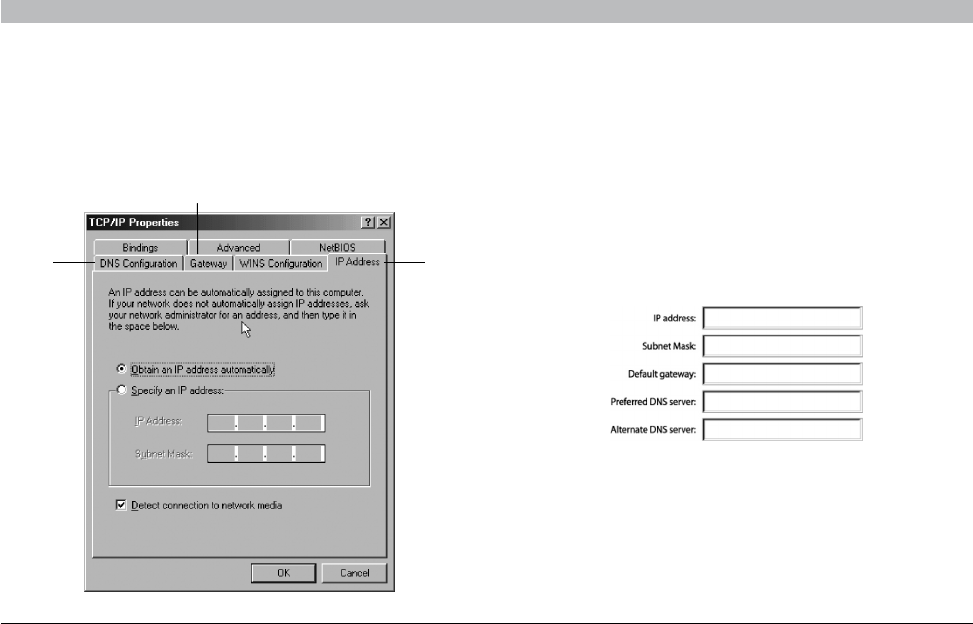
70
N+ Wireless Router
SECTIONSTable of Contents 123456 89107
MANUALLY CONFIGURING NETWORK SETTINGS
Manually Configuring Network Settings in Windows 98 or Me
1. Right-click on “My Network Neighborhood” and select “Properties”
from the drop-down menu.
2. Select “TCP/IP -> settings” for your installed network adapter. You
will see the following window
(1) (3)
(2)
3. If “Specify and IP address” is selected, your Router will need
to be set up for a static IP connection type. Write the address
information in the table below. You will need to enter this
information into the Router.
4. Write the IP address and subnet mask from the “IP Address” tab
(3).
5. Click the “Gateway” tab (2). Write the gateway address down in the
chart.
6. Click the “DNS Configuration” tab (1). Write the DNS address(es) in
the chart
7. If not already selected, select “Obtain IP address automatically” on
the IP address tab. Click “OK”.
Restart the computer. When the computer restarts, your network
settings are now configured for use with the Router.
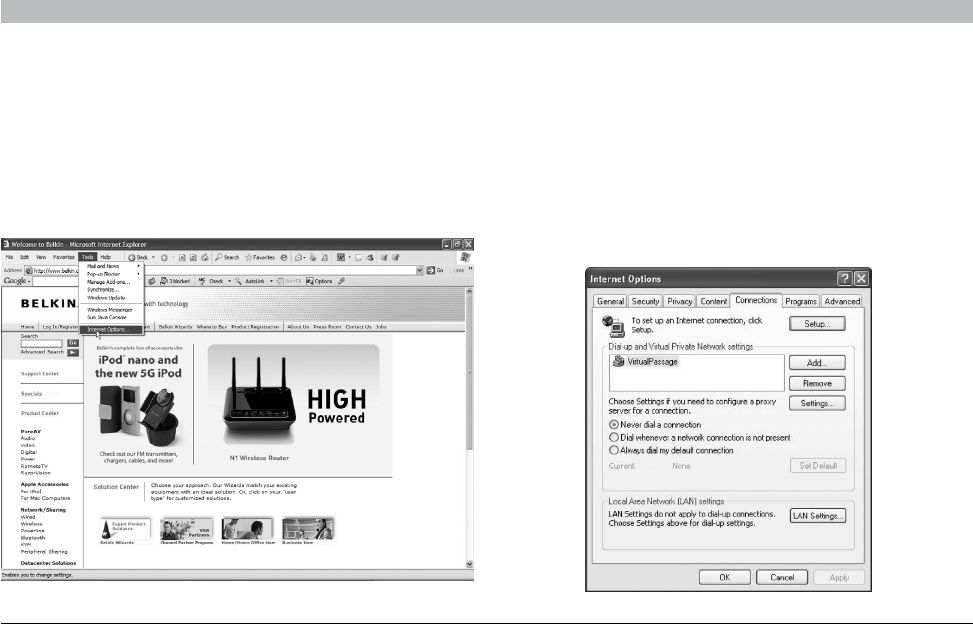
71
N+ Wireless Router
SECTIONSTable of Contents 1234567 910
RECOMMENDED WEB BROWSER SETTINGS
8
Recommended Web Browser Settings
In most cases, you will not need to make any changes to your web browser’s settings. If you are having trouble accessing the Internet or the Web-
Based Advanced User Interface, then change your browser’s settings to the recommended settings in this section.
2. In the “Internet Options” screen, there are three selections: “Never
dial a connection”, “Dial whenever a network connection is not
present”, and “Always dial my default connection”. If you can make
a selection, select “Never dial a connection”. If you cannot make a
selection, go to the next step.
Microsoft® Internet Explorer 4.0 or Higher
1. Start your web browser. Select “Tools” then “Internet Options”.
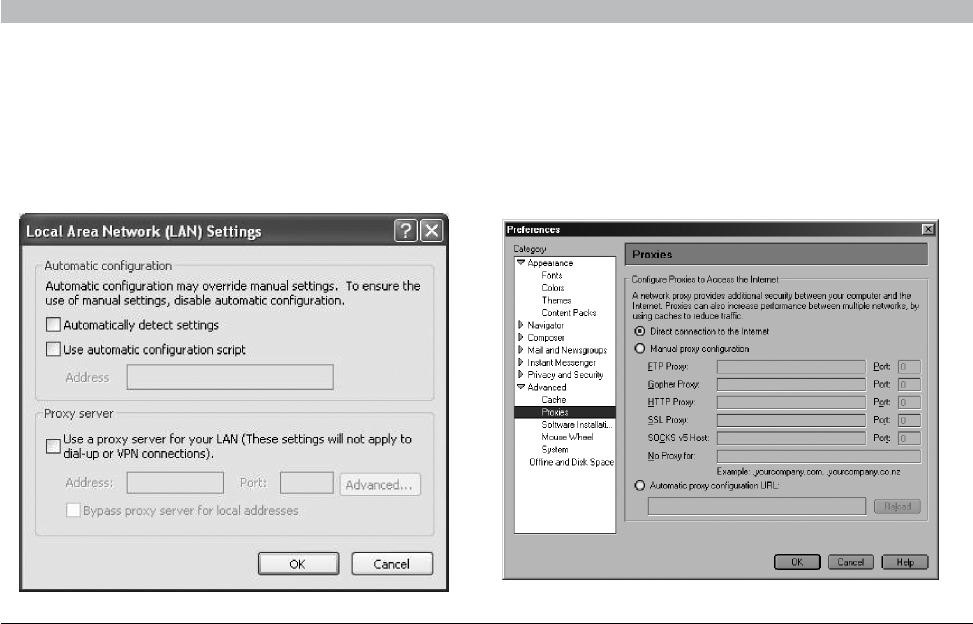
72
N+ Wireless Router
SECTIONSTable of Contents 1234567 9108
RECOMMENDED WEB BROWSER SETTINGS
3. Under the “Internet Options” screen, click on “Connections” and
select “LAN Settings…”.
4. Make sure there are no check marks next to any of the displayed
options: “Automatically detect settings”, “Use automatic
configuration script”, and “Use a proxy server”. Click “OK”. Then
click “OK” again in the “Internet Options” page.
Netscape® Navigator® 4.0 or Higher
1. Start Netscape. Click on “Edit” then “Preferences”.
2. In the “Preferences” window, click on “Advanced” then select
“Proxies”. In the “Proxies” window, select “Direct connection to the
Internet”.

73
N+ Wireless Router
SECTIONSTable of Contents 12345678 10
TROUBLESHOOTING
9
Troubleshooting
Setup Assistant CD does not automatically start.
If the CD-ROM does not start the Setup Assistant automatically, it could
be that the computer is running other applications that are interfering
with the CD drive.
1. If the Setup Assistant Welcome screen does not appear within
15-20 seconds, open up your CD-ROM drive by double-clicking on
the “My Computer” icon that is located on your desktop.
2. Next, double-click on the CD-ROM drive that the Setup Assistant
CD has been placed in to start the installation.
3. The Setup Assistant should start within a few seconds. If, instead,
a window appears showing the files on the CD, double-click on the
icon labeled “SetupAssistant”.
4. If the Setup Assistant still does not start, reference the section
titled “Manually Configuring Network Settings” (page 67) of this
User Manual for an alternative setup method).
Setup Assistant cannot find my Router.
If the Setup Assistant is not able to find the Router during the installation
process, please check the following items:
1. If the Setup Assistant is not able to find the Router during the
installation process, there may be third-party firewall software
installed on the computer attempting to access the Internet.
Examples of third-party firewall software are ZoneAlarm, BlackICE
PC Protection, McAfee Personal Firewall, and Norton Personal
Firewall. If you do have firewall software installed on your
computer, please make sure that you properly configure it. You can
determine if the firewall software is preventing Internet access by
temporarily turning it off. If, while the firewall is disabled, Internet
access works properly, you will need to change the firewall settings
to function properly when it is turned on. Please refer to the
instructions provided by the publisher of your firewall software for
instructions on configuring the firewall to allow Internet access.
2. Unplug power to the Router for 10 seconds, and then plug the
power back into the Router. Ensure that the Router’s “router” LED
is on; it should be solid BLUE. If not, check to make sure that the
AC adapter is connected to the Router and plugged into a wall
outlet.
3. Ensure that you have a cable connected between the network
(Ethernet) port on the back of the computer and one of the “to
Wired Computers” ports on the back of the Router.
Note: The computer should NOT be connected to the port labeled “to
Modem” on the back of the Router.
4. Try shutting down and restarting your computer, then rerunning the
Setup Assistant.
If the Setup Assistant is still unable to find the Router, reference the
section titled “Manually Configuring Network Settings” for installation
steps.

74
N+ Wireless Router
SECTIONSTable of Contents 12345678 109
TROUBLESHOOTING
Setup Assistant cannot connect my Router to the Internet.
If the Setup Assistant is not able to connect the Router to the Internet,
please check the following items:
1. Use the troubleshooting suggestions within the Setup Assistant.
2. If your ISP requires a user name and password, make sure that
you have typed in your user name and password correctly. Some
user names require that the ISP’s domain may be at the end of the
name. Example: “myname@myisp.com”. The “@myisp.com” part of
the user name may need to be typed as well as your user name.
If you continue to have no Internet connection, reference the section
titled “Manually Configuring Network Settings” (page xx of this User
Manual for an alternative setup method).
• TheSetupAssistantcompletedinstallation,butmyweb
browser doesn’t work.
• IamunabletoconnecttotheInternet.The“modem”LEDon
my Router is off, and the “internet” LED is blinking.
If you cannot connect to the Internet, and the “modem” LED is off, and
the “internet” LED is blinking, the problem may be that your modem and
Router are not connected properly.
1. Make sure the network cable between the modem and the Router
is connected. The cable should be connected at one end to the
Router’s “to Modem” port, and at the other end to the network port
on your modem.
2. Unplug the cable or DSL modem from its power source for three
minutes. After three minutes, plug the modem back into its power
source. This may force the modem to properly recognize the Router.
3. Unplug the power to your Router, wait 10 seconds, and then
reconnect the power. This will cause the Router to reattempt
communication with the modem. If the “modem” LED on the
Router is not lit after completing these steps, please contact Belkin
Technical Support.
4. Try shutting down and restarting your computer.
• TheSetupAssistantcompletedinstallation,butmyweb
browser doesn’t work.
• IamunabletoconnecttotheInternet.The“modem”LEDon
my Router is on, and the “internet” LED is blinking.
1. If you cannot connect to the Internet, the “modem” LED is on,
and the “internet” LED is blinking, the problem may be that your
connection type may not match the ISP’s connection.
2. If you have a “static IP address” connection, your ISP must assign
you the IP address, subnet mask, and gateway address. Please
refer to the section entitled “Alternate Setup Method” for details on
changing this setting.
3. If you have a “PPPoE” connection, your ISP will assign you a user
name and password and sometimes a service name. Make sure the
Router’s connection type is configured to PPPoE and the settings
are entered properly. Please refer to the section entitled “Alternate
Setup Method” for details on changing this setting.

75
N+ Wireless Router
SECTIONSTable of Contents 12345678 109
TROUBLESHOOTING
4. You may need to configure your Router to meet the specific
requirements of your ISP. To search our knowledge base for ISP-
specific issues, go to: http://web.belkin.com/support and type in
“ISP”.
If you are still unable to access the Internet after verifying these settings,
please contact Belkin Technical Support.
• TheSetupAssistantcompleted,butmywebbrowserdoesn’t
work.
• IamunabletoconnecttotheInternet.The“modem”LEDon
my Router is blinking, and the “internet” LED is solid.
1. If the “modem” LED is blinking, and the “internet” LED is solid,
but you are unable to access the Internet, there may be third-
party firewall software installed on the computer attempting to
access the Internet. Examples of third-party firewall software are
ZoneAlarm, BlackICE PC Protection, McAfee Personal Firewall, and
Norton Personal Firewall.
2. If you do have firewall software installed on your computer, please
make sure that you properly configure it. You can determine if
the firewall software is preventing Internet access by temporarily
turning it off. If, while the firewall is disabled, Internet access works
properly, you will need to change the firewall settings to function
properly when it is turned on.
3. Please refer to the instructions provided by the publisher of your
firewall software for instructions on configuring the firewall to allow
Internet access.
If you are still unable to access the Internet after disabling any firewall
software, please contact Belkin Technical Support.
I can’t connect to the Internet wirelessly.
If you are unable to connect to the Internet from a wireless computer,
please check the following items:
1. Look at the lights on your Router. If you’re using a Belkin Router,
the lights should be as follows:
• The“router”LEDshouldbeon.
• The“modem”lightshouldbeon,andnotblinking.
• The“internet”LEDshouldbeon,andnotblinking.
• The“Wireless”lightshouldbeon,notblinking
2. Open your wireless utility software by clicking on the icon in the
system tray at the bottom, right-hand corner of the screen.
3. The exact window that opens will vary depending on the model of
wireless card you have; however, any of the utilities should have
a list of “Available Networks”—those wireless networks it can
connect to.
Does the name of your wireless network appear in the results?
Yes, my network name is listed—go to the troubleshooting solution
titled “I can’t connect to the Internet wirelessly, but my network name is
listed”.
No, my network name is not listed—go to the troubleshooting solution
titled “I can’t connect to the Internet wirelessly, and my network name is
not listed”.

76
N+ Wireless Router
SECTIONSTable of Contents 12345678 109
TROUBLESHOOTING
I can’t connect to the Internet wirelessly, but my network name is listed.
If the name of your network is listed in the “Available Networks” list,
please follow the steps below to connect wirelessly:
1. Click on the correct network name in the “Available Networks” list.
2. If the network has security (encryption) enabled, you will need to
enter the network key. For more information regarding security, see
the section entitled “Changing the Wireless Security Settings”.
3. Within a few seconds, the tray icon in the lower, left-hand corner
of your screen should turn green, indication of a successful
connection to the network.
I can’t connect to the Internet wirelessly, and my network name is
not listed.
If the correct network name is not listed under “Available Networks” in
the wireless utility, please attempt the following troubleshooting steps:
1. Temporarily move computer, if possible, five to 10 feet from the
Router. Close the wireless utility, and reopen it. If the correct
network name now appears under “Available Networks”, you may
have a range or interference problem. Please see the suggestions
discussed in the section titled “Placement of your N+ Wireless
Router” of this User Manual.
2. Using a computer that is connected to the Router via a network
cable (as opposed to wirelessly), ensure that “Broadcast SSID” is
enabled. This setting is found on the Router’s wireless “Channel
and SSID” configuration page.
If you are still unable to access the Internet after completing these steps,
please contact Belkin Technical Support.
• Mywirelessnetworkperformanceisinconsistent.
• Datatransferissometimesslow.
• Signalstrengthispoor.
• Difficultyestablishingand/ormaintainingaVirtualPrivate
Network (VPN) connection.
Wireless technology is radio-based, which means connectivity and
the throughput performance between devices decreases when the
distance between devices increases. Other factors that will cause signal
degradation (metal is generally the worst culprit) are obstructions such
as walls and metal appliances. Note also that connection speed may
decrease as you move farther away from the Router.
In order to determine if wireless issues are related to range, we suggest
temporarily moving the computer, if possible, five to 10 feet from the
Router.
Changing the wireless channel—Depending on local wireless traffic
and interference, switching the wireless channel of your network can
improve performance and reliability. The default channel the Router
is shipped with is channel 11; you may choose from several other
channels depending on your region. See the section on page 39 entitled
“Changing the Wireless Channel” for instructions on how to choose
other channels.

77
N+ Wireless Router
SECTIONSTable of Contents 12345678 109
TROUBLESHOOTING
Limiting the wireless transmit rate—Limiting the wireless transmit rate
can help improve the maximum wireless range and connection stability.
Most wireless cards have the ability to limit the transmission rate. To
change this property, go to the Windows Control Panel, open “Network
Connections” and double-click on your wireless card’s connection. In
the properties dialog, select the “Configure” button on the “General” tab
(Windows 98 users will have to select the wireless card in the list box
and then click “Properties”), then choose the “Advanced” tab and select
the rate property.
Wireless client cards are usually set to automatically adjust the wireless
transmit rate for you, but doing so can cause periodic disconnects when
the wireless signal is too weak; as a rule, slower transmission rates are
more stable. Experiment with different connection rates until you find the
best one for your environment. Note that all available transmission rates
should be acceptable for browsing the Internet. For more assistance,
see your wireless card’s user manual.
I am having difficulty setting up Wired Equivalent Privacy (WEP)
security on my Belkin Router.
1. Log into your Router. Open your web browser and type in the IP
address of the Router. (The Router’s default is 192.168.2.1.) Log into
your Router by clicking on the “Login” button in the top right-hand
corner of the screen. You will be asked to enter your password. If
you never set a password, leave the “Password” field blank and
click “Submit”. Click the “Wireless” tab on the left of your screen.
Select the “Encryption” or “Security” tab to get to the security
settings page.
2. Select “128-bit WEP” from the drop-down menu.
3. After selecting your WEP encryption mode, you can type in your
hex WEP key manually, or you can type in a passphrase in the
“Passphrase” field and click “Generate” to create a WEP key from
the passphrase. Click “Apply Changes” to finish. You must now set
all of your clients to match these settings. A hex (hexadecimal) key
is a mixture of numbers and letters from A-F and 0-9. For 128-bit
WEP, you need to enter 26 hex keys. For example: C3 03 0F AF 4B
B2 C3 D4 4B C3 D4 E7 E4 = 128-bit key
4. Click “Apply Changes” to finish. Encryption in the Router is now
set. Each of your computers on your wireless network will now
need to be configured with the same security settings.
WARNING: If you are configuring the Router from a computer with a
wireless client, you will need to ensure that security is turned on for this
wireless client. If this is not done, you will lose your wireless connection.
Note to Mac Users: Original Apple AirPort products support 64-bit
encryption only. Apple AirPort 2 products can support 64-bit or 128-
bit encryption. Please check your Apple AirPort product to see which
version you are using. If you cannot configure your network with 128-bit
encryption, try 64-bit encryption.

78
N+ Wireless Router
SECTIONSTable of Contents 12345678 109
TROUBLESHOOTING
I am having difficulty setting up Wired Equivalent Privacy (WEP)
security on a Belkin client card.
The client card must use the same key as the Router. For instance, if
your Router uses the key 00112233445566778899AABBCC, then the
client card must be set to the exact same key.
1. Double-click the Signal Indicator icon to bring up the “Wireless
Network” screen.
2. The “Advanced” button will allow you to view and configure more
options of your card.
3. Once the “Advanced” button is clicked, the Belkin Wireless LAN
Utility will appear. This Utility will allow you to manage all the
advanced features of the Belkin Wireless Card.
4. Under the “Wireless Network Properties” tab, select a network
name from the “Available Networks” list and click the “Properties”
button.
5. Under “Data Encryption”, select “WEP”.
6. Ensure that the check box “The key is provided for me
automatically” at the bottom is unchecked. If you are using this
computer to connect to a corporate network, please consult your
network administrator if this box needs to be checked.
7. Type your WEP key in the “Network key” box.
Important: A WEP key is a mixture of numbers and letters from A-F and
0-9. For 128-bit WEP, you need to enter 26 keys. This network key needs
to match the key you assign to your Router.
For example:
C3 03 0F AF 4B B2 C3 D4 4B C3 D4 E7 E4 = 128-bit key
8. Click “OK”, and then “Apply” to save the settings.
If you are not using a Belkin wireless client card, please consult the
manufacturer’s user manual for that wireless client card.
Do Belkin products support WPA/WPA2?
Note: To use WPA security, all your clients must be upgraded to drivers
and software that support it. At the time of this FAQ publication, a
security patch download is available, for free, from Microsoft. This patch
works only with the Windows XP operating system.
Download the patch here: http://support.microsoft.com/?kbid=826942
You also need to download the latest driver for your Belkin 802.11g
Wireless Desktop or Notebook Network Card from the Belkin support
site. Other operating systems are not supported at this time. Microsoft’s
patch only supports devices with WPA-enabled drivers such as Belkin
802.11g products.
Download the latest driver at http://www.belkin.com/support

79
N+ Wireless Router
SECTIONSTable of Contents 12345678 109
TROUBLESHOOTING
I am having difficulty setting up Wireless Protected Access (WPA)
security on my Belkin Router for a home network.
1. From the “Security Mode” drop-down menu, select “WPA-PSK (no
server)”.
2. For “Encryption Technique”, select “TKIP” or “AES”. This setting
will have to be identical on the clients that you set up.
3. Enter your pre-shared key. This can be from eight to 63 characters
and can be letters, numbers, symbols, or spaces. This same key
must be used on all of the clients that you set up. For example,
your PSK might be something like: “Smith family network key”.
4. Click “Apply Changes” to finish. You must now set all clients to
match these settings.
I am having difficulty setting up Wireless Protected Access (WPA)
security on a Belkin wireless client card for a home network.
Clients must use the same key that the Router uses. For instance, if the
key is “Smith Family Network Key” in the Router, the clients must also
use that same key.
1. Double-click the Signal Indicator icon to bring up the “Wireless
Network” screen. The “Advanced” button will allow you to view and
configure more options of your card.
2. Once the “Advanced” button is clicked, the Belkin Wireless Utility
will appear. This Utility will allow you to manage all the advanced
features of the Belkin Wireless Card.
3. Under the “Wireless Network Properties” tab, select a network
name from the “Available Networks” list and click the “Properties”
button.
4. Under “Network Authentication”, select “WPA-PSK (no server).
5. Type your WPA key in the “Network key” box.
Important: WPA-PSK is a mixture of numbers and letters from A-Z and
0-9. For WPA-PSK you can enter eight to 63 characters. This network
key needs to match the key you assign to your Router.
6. Click “OK, then “Apply” to save the settings.

80
N+ Wireless Router
SECTIONSTable of Contents 12345678 109
TROUBLESHOOTING
I am NOT using a Belkin client card for a home network and I am
having difficulty setting up Wireless Protected Access (WPA)
security.
If you are not using a Belkin Wireless Desktop or Wireless Notebook
Network Card that is not equipped with WPA-enabled software, a
file from Microsoft called “Windows XP Support Patch for Wireless
Protected Access” is available for free download. Download the patch
from Microsoft by searching the knowledge base for Windows XP WPA.
Note: The file that Microsoft has made available works only with
Windows XP. Other operating systems are not supported at this time.
You also need to ensure that the wireless card’s manufacturer supports
WPA and that you have downloaded and installed the latest driver from
their support site.
Supported Operating Systems:
•WindowsXPProfessional
•WindowsXPHomeEdition
1. Under Windows XP, click “Start > Control Panel > Network
Connections”.
2. Right-clicking on the “Wireless Networks” tab will display the
following screen. Ensure the “Use Windows to configure my
wireless network settings” check box is checked. [need image]
3. Under the “Wireless Networks” tab, click the “Configure” button
and you will see the following screen. [need image]
4. For a home or small business user, select “WPA-PSK” under
“Network Administration”.
Note: Select WPA (with radius server) if you are using this computer to
connect to a corporate network that supports an authentication server
such as a radius server. Please consult your network administrator for
further information.
5. Select “TKIP” or “AES” under “Date Encryption”. This setting will
have to be identical to the Router that you set up.
6. Type in your encryption key in the “Network key” box.
Important: Enter your pre-shared key. This can be from eight to 63
characters and can be letters, numbers, or symbols. This same key
must be used on all of the clients that you set up.
7. Click “OK” to apply settings.

81
N+ Wireless Router
SECTIONSTable of Contents 12345678 109
TROUBLESHOOTING
What’s the difference between 802.11g and draft 802.11n?
Currently there are three commonly used wireless networking standards,
which transmit data at very different maximum speeds. Each is based
on the designation for certifying network standards. The most common
wireless networking standard, 802.11g, can transmit information up
to 54Mbps; 802.11a also supports up to 54Mbps, but in the 5GHz
frequency; and 802.11n draft specification can connect at up to
300Mbps. See the following chart for more detailed information.
Wireless
Technology
G
(802 .11g)
G Plus MIMO
(802 .11g w i t h
MIMO MRC)
N MIMO
(draft 802.11n
with MIMO)
N1 MIMO
(draft 802.11n
with MIMO)
Speed/Data
Rate*
Up to 54Mbps* Up to 54Mbps* Up to 300Mbps* Up to 300Mbps*
Frequency Common
household
devices such as
cordless phones
and microwave
ovens may
interfere with
the unlicensed
band 2.4GHz
Common
household
devices such as
cordless phones
and microwave
ovens may
interfere with
the unlicensed
band 2.4GHz
Common
household
devices such as
cordless phones
and microwave
ovens may
interfere with
the unlicensed
band 2.4GHz
Common
household
devices such as
cordless phones
and microwave
ovens may
interfere with
the unlicensed
band 2.4GHz
Compatibility Compatible with
802.11b/g
Compatible with
802.11b/g
Compatible with
draft 802.11n**
and 802.11b/g
Compatible with
draft 802.11n**
and 802.11b/g
Coverage* Up to 400 ft.* Up to 1,000 ft.* Up to 1,200 ft.* Up to 1,400 ft.*
Advantage Common—
widespread
use for Internet
sharing
Better coverage
and consistent
speed and
range
Enhanced
speed and
coverage
Leading edge—
best coverage
and throughput
**Distance and connection speeds will vary depending on your networking environment.
**This Router is compatible with products based on the same version of the draft 802.11n
specifications and may require a software upgrade for best results.
Belkin Wireless Comparison Chart

82
N+ Wireless Router
SECTIONSTable of Contents 123456789
INFORMATION
10
Technical Support
You can find technical support information at http://www.belkin.com/
networking or www.belkin.com through the tech support area. If you
want to contact technical support by phone, please call:
US: 877-736-5771
800-223-5546 ext. 2263
310-898-1100 ext. 2263
UK: 0845 607 77 87
Australia: 1800 235 546
New Zealand: 0800 235 546
Singapore: 65 64857620
Europe: www.belkin.com/support
Information
FCC Statement
DECLARATION OF CONFORMITY WITH FCC RULES FOR
ELECTROMAGNETIC COMPATIBILITY
We, Belkin International, Inc., of 501 West Walnut Street, Compton, CA
90220, declare under our sole responsibility that the device,
F5D8235-4v2
complies with Part 15 of the FCC Rules. Operation is subject to
the following two conditions: (1) this device may not cause harmful
interference, and (2) this device must accept any interference received,
including interference that may cause undesired operation.

83
N+ Wireless Router
SECTIONSTable of Contents 12345678910
INFORMATION
Caution: Exposure to Radio Frequency Radiation.
The device shall be used in such a manner that the potential for human
contact normal operation is minimized.
This equipment complies with FCC radiation exposure limits set forth for
an uncontrolled environment. This equipment should be installed and
operated with a minimum distance of 20cm between the radiator and
your body.
Federal Communications Commission Notice
This equipment has been tested and found to comply with the limits for
a Class B digital device, pursuant to Part 15 of the FCC Rules. These
limits are designed to provide reasonable protection against harmful
interference in a residential installation.
This equipment generates, uses, and can radiate radio frequency
energy, and if not installed and used in accordance with the instructions,
may cause harmful interference to radio communications. However,
there is no guarantee that interference will not occur in a particular
installation. If this equipment does cause harmful interference to radio or
television reception, which can be determined by turning the equipment
off and on, the user is encouraged to try and correct the interference by
one or more of the following measures:
•Reorientorrelocatethereceivingantenna.
•Increasethedistancebetweentheequipmentandthereceiver.
•Connecttheequipmenttoanoutletonacircuitdifferentfromthatto
which the receiver is connected.
•Consultthedealeroranexperiencedradio/TVtechnicianforhelp.
For IEEE 802.11b/g/n products in the USA market, only channels 1
through 11 can be operated. Selection of other channels is not possible.
This device and its antenna(s) must not be co-located or operating
in conjunction with any other antenna or transmitter.
Modifications
The FCC requires the user to be notified that any changes or
modifications to this device that are not expressly approved by
Belkin International, Inc., may void the user’s authority to operate the
equipment.
Industry Canada Statement
This device complies with RSS-210 of the Industry Canada Rules.
Operation is subject to the following two conditions:
(1) This device may not cause harmful interference, and (2) this device
must accept any interference received, including interference that may
cause undesired operation.

84
N+ Wireless Router
SECTIONSTable of Contents 12345678910
INFORMATION
IMPORTANT NOTE:
Radiation Exposure Statement
This equipment complies with IC radiation exposure limits set forth for
an uncontrolled environment. This equipment should be installed and
operated with a minimum distance of 20cm between the radiator and your
body. This device has been designed to operate with an antenna having a
maximum gain of 2 dB. An antenna with a higher gain is strictly prohibited
per regulations of Industry Canada. The required antenna impedance is
50 Ohms.
Europe – EU Declaration of Conformity
This device complies with the essential requirements of the R&TTE
Directive 1999/5/EC. The following test methods have been applied in
order to prove presumption of conformity with the essential requirements
of the R&TTE Directive 1999/5/EC:
EN60950-1: 2006
Safety of Information Technology Equipment
EN50385: 2002-08
Product standard to demonstrate the compliance of radio base stations
and fixed terminal stations for wireless telecommunication systems with
the basic restrictions or the reference levels related to human exposure to
radio frequency electromagnetic fields (110MHz - 40GHz) - General public
EN 300 328 V1.7.1: 2006-10
Electromagnetic compatibility and radio spectrum matters (ERM);
wideband transmission systems; data transmission equipment operating
in the 2.4GHz ISM band and using spread spectrum modulation
techniques; harmonized EN covering essential requirements under article
3.2 of the R&TTE Directive
EN 301 489-1 V1.8.1: 2008
Electromagnetic compatibility and radio spectrum matters (ERM);
electromagnetic compatibility (EMC) standard for radio equipment and
services; Part 1: Common technical requirements
EN 301 489-17 V1.3.2: 2008
Electromagnetic compatibility and radio spectrum matters (ERM);
electromagnetic compatibility (EMC) standard for radio equipment and
services; Part 17: Specific conditions for 2.4GHz wideband transmission
systems and 5GHz high performance RLAN equipment
This device is a 2.4GHz wideband transmission system (transceiver),
intended for use in all EU member states and EFTA countries, except in
France and Italy where restrictive use applies.
In Italy the end user should apply for a license at the national spectrum
authorities in order to obtain authorization to use the device for
setting up outdoor radio links and/or for supplying public access to
telecommunications and/or network services.
This device may not be used for setting up outdoor radio links in France
and in some areas the RF output power may be limited to 10mW EIRP in
the frequency range of 2454 – 2483.5MHz. For detailed information, the
end user should contact the national spectrum authority in France.
.
.
EN 301 489-1 V1.6.1: 2005
EN 301 489-17 V1.2.1: 2002

85
N+ Wireless Router
SECTIONSTable of Contents 12345678910
INFORMATION
Česky [Czech] [Jméno výrobce] tímto prohlašuje, že tento [typ zařízení] je ve shodě se základními požadavky a dalšími příslušnými ustanoveními směrnice 1999/5/ES.
Dansk [Danish] Undertegnede [fabrikantens navn] erklærer herved, at følgende udstyr [udstyrets typebetegnelse] overholder de væsentlige krav og øvrige relevante krav i direktiv 1999/5/EF.
Deutsch [German] Hiermit erklärt [Name des Herstellers], dass sich das Gerät [Gerätetyp] in Übereinstimmung mit den grundlegenden Anforderungen und den übrigen einschlägigen Bestimmungen
der Richtlinie 1999/5/EG befindet.
Eesti [Estonian] Käesolevaga kinnitab [tootja nimi = name of manufacturer] seadme [seadme tüüp = type of equipment] vastavust direktiivi 1999/5/EÜ põhinõuetele ja nimetatud direktiivist
tulenevatele teistele asjakohastele sätetele.
English Hereby, [name of manufacturer], declares that this [type of equipment] is in compliance with the essential requirements and other relevant provisions of Directive 1999/5/EC.
Español [Spanish] Por medio de la presente [nombre del fabricante] declara que el [clase de equipo] cumple con los requisitos esenciales y cualesquiera otras disposiciones aplicables o exigibles
de la Directiva 1999/5/CE.
Ελληνική [Greek] ΜΕ ΤΗΝ ΠΑΡΟΥΣΑ [name of manufacturer] ΔΗΛΩΝΕΙ ΟΤΙ [type of equipment] ΣΥΜΜΟΡΦΩΝΕΤΑΙ ΠΡΟΣ ΤΙΣ ΟΥΣΙΩΔΕΙΣ ΑΠΑΙΤΗΣΕΙΣ ΚΑΙ ΤΙΣ ΛΟΙΠΕΣ ΣΧΕΤΙΚΕΣ ΔΙΑΤΑΞΕΙΣ ΤΗΣ
ΟΔΗΓΙΑΣ 1999/5/ΕΚ.
Français [French] Par la présente [nom du fabricant] déclare que l'appareil [type d'appareil] est conforme aux exigences essentielles et aux autres dispositions pertinentes de la directive 1999/5/CE.
Italiano [Italian] Con la presente [nome del costruttore] dichiara che questo [tipo di apparecchio] è conforme ai requisiti essenziali ed alle altre disposizioni pertinenti stabilite dalla direttiva 1999/5/CE.
Latviski [Latvian] Ar šo [name of manufacturer / izgatavotāja nosaukums] deklarē, ka [type of equipment / iekārtas tips] atbilst Direktīvas 1999/5/EK būtiskajām prasībām un citiem ar to saistītajiem
noteikumiem.
Lietuvių [Lithuanian] Šiuo [manufacturer name] deklaruoja, kad šis [equipment type] atitinka esminius reikalavimus ir kitas 1999/5/EB Direktyvos nuostatas.
Nederlands [Dutch] Hierbij verklaart [naam van de fabrikant] dat het toestel [type van toestel] in overeenstemming is met de essentiële eisen en de andere relevante bepalingen van richtlijn 1999/5/EG.
Malti [Maltese] Hawnhekk, [isem tal-manifattur], jiddikjara li dan [il-mudel tal-prodott] jikkonforma mal-ħtiġijiet essenzjali u ma provvedimenti oħrajn relevanti li hemm fid-Dirrettiva 1999/5/EC.
Magyar [Hungarian] Alulírott, [gyártó neve] nyilatkozom, hogy a [... típus] megfelel a vonatkozó alapvetõ követelményeknek és az 1999/5/EC irányelv egyéb elõírásainak.
Polski [Polish] Niniejszym [nazwa producenta] oświadcza, że [nazwa wyrobu] jest zgodny z zasadniczymi wymogami oraz pozostałymi stosownymi postanowieniami Dyrektywy 1999/5/EC.
Português [Portuguese] [Nome do fabricante] declara que este [tipo de equipamento] está conforme com os requisitos essenciais e outras disposições da Directiva 1999/5/CE.
Slovensko [Slovenian] [Ime proizvajalca] izjavlja, da je ta [tip opreme] v skladu z bistvenimi zahtevami in ostalimi relevantnimi določili direktive 1999/5/ES.
Slovensky [Slovak] [Meno výrobcu] týmto vyhlasuje, že [typ zariadenia] spĺňa základné požiadavky a všetky príslušné ustanovenia Smernice 1999/5/ES.
Suomi [Finnish] [Valmistaja = manufacturer] vakuuttaa täten että [type of equipment = laitteen tyyppimerkintä] tyyppinen laite on direktiivin 1999/5/EY oleellisten vaatimusten ja sitä koskevien
direktiivin muiden ehtojen mukainen.
Svenska [Swedish] Härmed intygar [företag] att denna [utrustningstyp] står I överensstämmelse med de väsentliga egenskapskrav och övriga relevanta bestämmelser som framgår av direktiv 1999/5/EG.

86
N+ Wireless Router
SECTIONSTable of Contents 12345678910
INFORMATION
Belkin International, Inc., Limited 1-Year Product Warranty
What is not covered by this warranty?
All above warranties are null and void if the Belkin product is not
provided to Belkin for inspection upon Belkin’s request at the sole
expense of the purchaser, or if Belkin determines that the Belkin product
has been improperly installed, altered in any way, or tampered with.
The Belkin Product Warranty does not protect against acts of God such
as flood, earthquake, lightning, war, vandalism, theft, normal-use wear
and tear, erosion, depletion, obsolescence, abuse, damage due to low
voltage disturbances (i.e. brownouts or sags), non-authorized program,
or system equipment modification or alteration.
How to get service.
To get service for your Belkin product you must take the following steps:
1. Contact Belkin International, Inc., at 501 W. Walnut St., Compton CA
90220, Attn: Customer Service, or call (800)-223-5546, within 15 days of
the Occurrence. Be prepared to provide the following information:
a. The part number of the Belkin product.
b. Where you purchased the product.
c. When you purchased the product.
d. Copy of original receipt.
2. Your Belkin Customer Service Representative will then instruct you on
how to forward your receipt and Belkin product and how to proceed
with your claim.
What this warranty covers.
Belkin International, Inc. (“Belkin”) warrants to the original purchaser of
this Belkin product that the product shall be free of defects in design,
assembly, material, or workmanship.
What the period of coverage is.
Belkin warrants the Belkin product for one year.
What will we do to correct problems?
Product Warranty.
Belkin will repair or replace, at its option, any defective product free of
charge (except for shipping charges for the product). Belkin reserves the
right to discontinue any of its products without notice, and disclaims any
limited warranty to repair or replace any such discontinued products.
In the event that Belkin is unable to repair or replace the product (for
example, because it has been discontinued), Belkin will offer either a
refund or a credit toward the purchase of another product from Belkin.
com in an amount equal to the purchase price of the product as evidenced
on the original purchase receipt as discounted by its natural use.

87
N+ Wireless Router
SECTIONSTable of Contents 12345678910
INFORMATION
Belkin reserves the right to review the damaged Belkin product. All
costs of shipping the Belkin product to Belkin for inspection shall be
borne solely by the purchaser. If Belkin determines, in its sole discretion,
that it is impractical to ship the damaged equipment to Belkin, Belkin
may designate, in its sole discretion, an equipment repair facility to
inspect and estimate the cost to repair such equipment. The cost, if any,
of shipping the equipment to and from such repair facility and of such
estimate shall be borne solely by the purchaser. Damaged equipment
must remain available for inspection until the claim is finalized.
Whenever claims are settled, Belkin reserves the right to be subrogated
under any existing insurance policies the purchaser may have.
How state law relates to the warranty.
THIS WARRANTY CONTAINS THE SOLE WARRANTY OF BELKIN.
THERE ARE NO OTHER WARRANTIES, EXPRESSED OR, EXCEPT AS
REQUIRED BY LAW, IMPLIED, INCLUDING THE IMPLIED WARRANTY
OR CONDITION OF QUALITY, MERCHANTABILITY OR FITNESS FOR A
PARTICULAR PURPOSE, AND SUCH IMPLIED WARRANTIES, IF ANY,
ARE LIMITED IN DURATION TO THE TERM OF THIS WARRANTY.
Some states do not allow limitations on how long an implied warranty
lasts, so the above limitations may not apply to you.
IN NO EVENT SHALL BELKIN BE LIABLE FOR INCIDENTAL, SPECIAL,
DIRECT, INDIRECT, CONSEQUENTIAL OR MULTIPLE DAMAGES SUCH
AS, BUT NOT LIMITED TO, LOST BUSINESS OR PROFITS ARISING
OUT OF THE SALE OR USE OF ANY BELKIN PRODUCT, EVEN IF
ADVISED OF THE POSSIBILITY OF SUCH DAMAGES.
This warranty gives you specific legal rights, and you may also have
other rights, which may vary from state to state. Some states do not
allow the exclusion or limitation of incidental, consequential, or other
damages, so the above limitations may not apply to you.
Belkin Tech Support
US: 877-736-5771
800-223-5546 ext. 2263
310-898-1100 ext. 2263
UK: 0845 607 77 87
Australia: 1800 235 546
New Zealand: 0800 235 546
Singapore: 65 64857620
Europe: www.belkin.com/support

Belkin International, Inc.
501 West Walnut Street
Los Angeles, CA 90220, USA
310-898-1100
310 -898-1111 fax
Belkin Ltd.
Express Business Park, Shipton Way
Rushden, NN10 6GL,
United Kingdom
+44 (0) 1933 35 2000
+44 (0) 1933 31 2000 fax
Belkin B.V.
Boeing Avenue 333
1119 PH Schiphol-Rijk,
The Netherlands
+31 (0) 20 654 7300
+31 (0) 20 654 7349 fax
Belkin Ltd.
4 Pioneer Avenue
Tuggerah Business Park
Tuggerah, NSW 2259, Australia
+61 (0) 2 4350 4600
+61 (0) 2 4350 4700 fax
© 2009 Belkin International, Inc. All rights reserved. All trade names are registered trademarks of
respective manufacturers listed. Mac, Mac OS, Apple, and AirPort are trademarks of Apple Inc., registered
in the U.S. and other countries. Windows, NT, Microsoft, and Windows Vista are either registered
trademarks or trademarks of Microsoft Corporation in the United States and/or other countries.